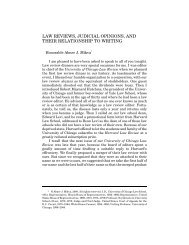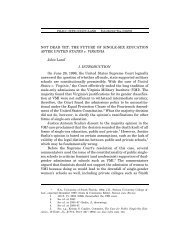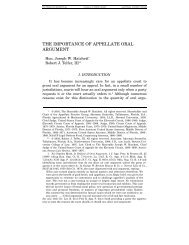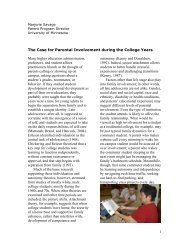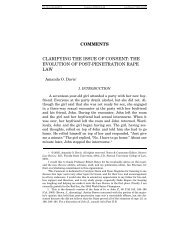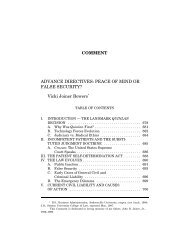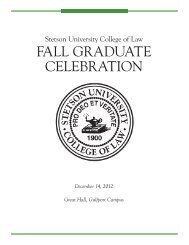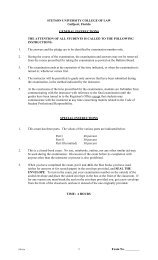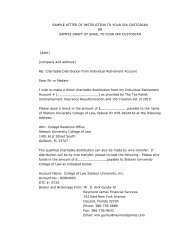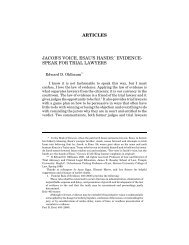Student Success, Retention, and Graduation: Definitions, Theories ...
Student Success, Retention, and Graduation: Definitions, Theories ...
Student Success, Retention, and Graduation: Definitions, Theories ...
Create successful ePaper yourself
Turn your PDF publications into a flip-book with our unique Google optimized e-Paper software.
Noel-Levitz <strong>Retention</strong> Codifications<strong>Student</strong> <strong>Success</strong>, <strong>Retention</strong>, <strong>and</strong> <strong>Graduation</strong>:<strong>Definitions</strong>, <strong>Theories</strong>, Practices, Patterns, <strong>and</strong> TrendsNovember 2008Page 19Academic advising for student success <strong>and</strong> retention: This is a video-based trainingprogram, designed to strengthen advising on campus.Connection NOW Online Course – How to Provide Winning Service: This onlinecourse provides a quality service training <strong>and</strong> development opportunity for staff acrosscampus <strong>and</strong> serves to reinforce the value of student-centeredness.Connections <strong>and</strong> Advanced Connections: This campus personnel training <strong>and</strong>development program is designed to raise the level of student satisfaction by improvingstudent services across campus.References <strong>and</strong> ResourcesACT, Inc. (2008). Act Institutional Data File, 2008.www.act.org/path/policy/pdf/retain_2008Astin, A. W. (1984). “<strong>Student</strong> involvement: A developmental theory for higher education.”Journal of College <strong>Student</strong> Personnel, 25 (2), 297-308.Astin, A.W. (1997). What Matters in College? Four Critical Years Revisited. SanFrancisco, CA: Jossey-Bass.Bean, J. P. (1980). “Dropouts <strong>and</strong> turnover: The synthesis <strong>and</strong> test of a casual model ofstudent attrition.” Research in Higher Education, 12 (2), 155-187.Bean, J. P., <strong>and</strong> Eaton, S.B. (2000). “A psychological Model of College <strong>Student</strong> <strong>Retention</strong>.”In J. M. Braxton, Ed., Rethinking the Departure Puzzle: New Theory <strong>and</strong> Research onCollege <strong>Student</strong> <strong>Retention</strong>. Nashville, TN: V<strong>and</strong>erbilt University Press.Berger, J. B., <strong>and</strong> Lyons, S. (2005). “Past to present: A historical look at retention.” InSiedman, A. (Ed.). College <strong>Student</strong> <strong>Retention</strong>: Formula of <strong>Student</strong> <strong>Success</strong>. Westport, CT:Praeger Press.Bonham, L. A., <strong>and</strong> Luckie, J. I. (1993). “Community college retention: Differentiatingamong stopouts, dropouts, <strong>and</strong> optouts.” Community College Journal of Research <strong>and</strong>Practice, 17, 543-554.Boyer, E. (1987). College: The Undergraduate Experience in America. New York, NY:Harper <strong>and</strong> Row.Braxton, J. M., Ed. (2000). Rethinking the Departure Puzzle: New Theory <strong>and</strong> Research onCollege <strong>Student</strong> <strong>Retention</strong>. Nashville, TN: V<strong>and</strong>erbilt University Press.Braxton, J. M., <strong>and</strong> Hirschy, A. S. (2005). “Theoretical developments in the study ofcollege student departure.” In Siedman, A. (Ed.). College <strong>Student</strong> <strong>Retention</strong>: Formula for<strong>Student</strong> <strong>Success</strong>. Westport, CT: Praeger Press.Cabrera, A. F., Castaneda, M. B., Nora, A. & Hengstler, D. (1992). “The convergencebetween two theories of college persistence.” Journal of Higher Education, 63 (2), 143-164.



